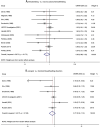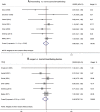Breastfeeding and the risk of childhood cancer: a systematic review and dose-response meta-analysis
- PMID: 33845843
- PMCID: PMC8042913
- DOI: 10.1186/s12916-021-01950-5
Breastfeeding and the risk of childhood cancer: a systematic review and dose-response meta-analysis
Abstract
Background: The aim of this study was to quantitatively summarize the available evidence on the association of breastfeeding with the risk of childhood cancer.
Methods: A literature search of PubMed and Embase databases was performed to identify eligible observational studies published from inception to July 17, 2020. The categorical and dose-response meta-analysis was conducted by pooling relative risk (RR) or odds ratio (OR) estimates with 95% confidence intervals (CIs). Potential sources of heterogeneity were detected by meta-regression and stratification analysis. Sensitivity analysis and publication bias test were also carried out.
Results: Forty-five articles involving 475,579 individuals were included in the meta-analysis. Among the thirty-three studies on the association between breastfeeding and risk of childhood leukemia, the pooled risk estimates were 0.77 (95% CI, 0.65-0.91) and 0.77 (95% CI 0.63-0.94) for ever versus non/occasional breastfeeding and longest versus shortest breastfeeding duration group, respectively. There was clear indication for non-linear dose-response relationship between breastfeeding duration and the risk of childhood leukemia (P non-linear < 0.001). The most protective effect (OR, 0.66, 95% CI 0.62-0.70) was observed at a breastfeeding duration of 9.6 months. Four studies examined, the association between breastfeeding and risk of childhood neuroblastoma, and significant inverse associations were consistently observed in both the comparisons of ever breastfeeding versus non/occasional breastfeeding (OR = 0.59, 95% CI 0.44-0.81) and longest versus shortest breastfeeding (OR = 0.61, 95% CI 0.44-0.83). However, no associations of breastfeeding with risk of other cancers were found.
Conclusions: Our study supports a protective role of breastfeeding on the risk of childhood leukemia, also suggesting a non-linear dose-response relationship. Further studies are warranted to confirm the association between breastfeeding and risk of childhood neuroblastoma.
Keywords: Breastfeeding; Childhood cancer; Dose-response; Meta-analysis.
Conflict of interest statement
The authors have declared no conflict of interests.
Figures




Similar articles
-
Role of breastfeeding on maternal and childhood cancers: An umbrella review of meta-analyses.J Glob Health. 2023 Jun 23;13:04067. doi: 10.7189/jogh.13.04067. J Glob Health. 2023. PMID: 37350093 Free PMC article.
-
Association between breastfeeding and breast cancer risk: evidence from a meta-analysis.Breastfeed Med. 2015 Apr;10(3):175-82. doi: 10.1089/bfm.2014.0141. Epub 2015 Mar 18. Breastfeed Med. 2015. PMID: 25785349 Review.
-
Association between breastfeeding and risk of endometrial cancer: a meta-analysis of epidemiological studies.Eur J Cancer Prev. 2018 Mar;27(2):144-151. doi: 10.1097/CEJ.0000000000000186. Eur J Cancer Prev. 2018. PMID: 26258808
-
A Meta-Analysis of the Association Between Breastfeeding and Early Childhood Obesity.J Pediatr Nurs. 2020 Jul-Aug;53:57-66. doi: 10.1016/j.pedn.2020.04.024. Epub 2020 May 25. J Pediatr Nurs. 2020. PMID: 32464422 Review.
-
The association between breastfeeding and childhood obesity: a meta-analysis.BMC Public Health. 2014 Dec 13;14:1267. doi: 10.1186/1471-2458-14-1267. BMC Public Health. 2014. PMID: 25495402 Free PMC article.
Cited by
-
Effects of Prenatal Breastfeeding Education on Breastfeeding Duration Beyond 12 Weeks: A Systematic Review.Health Educ Behav. 2024 Oct;51(5):665-676. doi: 10.1177/10901981231220668. Epub 2024 Jan 19. Health Educ Behav. 2024. PMID: 38240358 Free PMC article.
-
Association between medically diagnosed postnatal infection and childhood cancers: A matched case-control study in Denmark, 1978 to 2016.Int J Cancer. 2023 Sep 1;153(5):994-1002. doi: 10.1002/ijc.34604. Epub 2023 May 27. Int J Cancer. 2023. PMID: 37243370 Free PMC article.
-
The association between being breastfed in infancy and risks of cancer in adulthood-a UK Biobank study.BJC Rep. 2024 May 14;2(1):40. doi: 10.1038/s44276-024-00061-x. BJC Rep. 2024. PMID: 39516316 Free PMC article.
-
Integration of Breastfeeding Consultation and Practices in the Scope of Pediatric Dentistry: Collaboration with Lactation Specialists.Int J Clin Pediatr Dent. 2023 Nov;16(Suppl 3):306-310. doi: 10.5005/jp-journals-10005-2698. Int J Clin Pediatr Dent. 2023. PMID: 38268628 Free PMC article. Review.
-
Breastfeeding Beyond Six Months: Evidence of Child Health Benefits.Nutrients. 2024 Nov 14;16(22):3891. doi: 10.3390/nu16223891. Nutrients. 2024. PMID: 39599677 Free PMC article. Review.
References
Publication types
MeSH terms
LinkOut - more resources
Full Text Sources
Other Literature Sources
Medical

